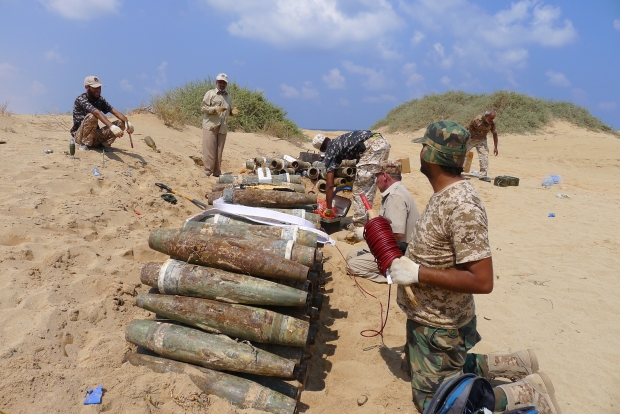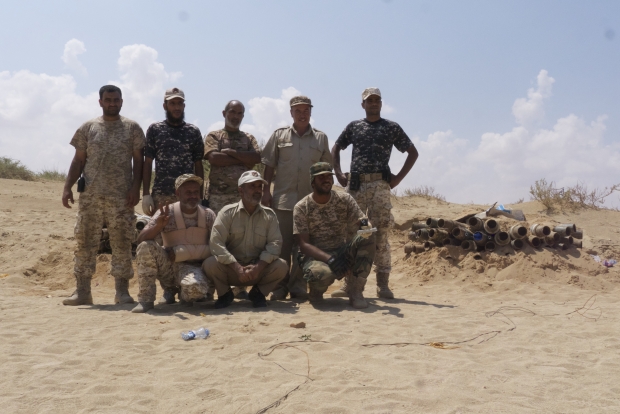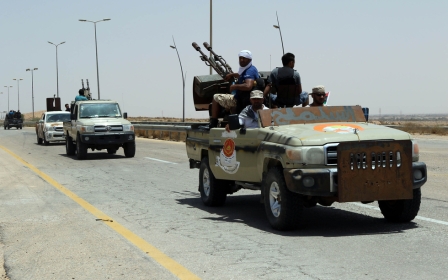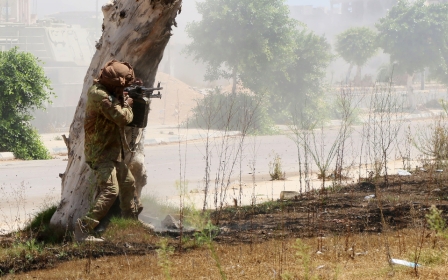Fairy lights, hospital syringes, black flags: Devious IEDs left by IS in Libya
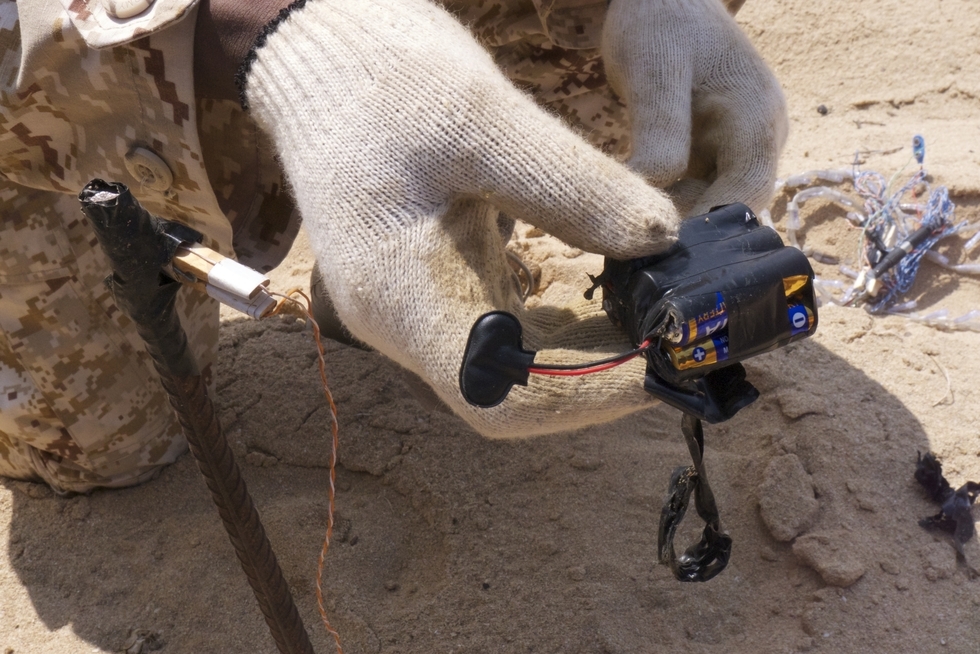
Under the searing sun on the Mediterranean shoreline, Libyan military engineers carefully stack ageing 155mm shells - currently one of the Islamic State (IS) group's most frequently used IEDs, left cunningly rigged to door handles, window fastenings and ordinary household objects.
Between the shells, disposal experts laid other explosives - mortar grenade heads found packed into tyres, detonation devices, small missiles and even two handmade IS suicide belts stripped from dead militants who were killed before they could blow themselves up.
“These suicide belts are filled with some kind of handmade explosive but we don’t actually know what it even is. We have never seen this type of stuff before,” Commander Mohammed Torjiman told Middle East Eye, pointing to the sliced-open packages of white and yellow powder taped to the belts which would have been detonated with a grenade component. “Once the grenade pin is pulled, these belts detonate within six seconds,” he said.
The engineers have cleared Sirte of some 5,000 improvised explosive devices (IEDs), booby traps and mines laid by IS, and this week they detonated 10 tonnes of explosives in a controlled blast carried out with no international assistance.
The de-miners packed semtex into the tips of shells and ran cables between the two piles which were partially buried in the sand to contain the blast. They drove to a safe distance of one-and-a-half kilometres to conduct the detonation.
The massive blast was heard and felt across Sirte. Unsuspecting groups of Libyan fighters threw themselves to the ground, fearing the explosion was yet another suicide car bomb, which IS is now using on almost a daily basis in their final defence of Sirte - the town they had claimed as their Mediterranean stronghold for more than a year.
“This is the fourth major controlled explosion we have conducted since the fight against IS began four months ago and, containing more than 200 munitions, this is our biggest yet,” said Commander Torjiman, overseeing the remote detonation in sand dunes on the outskirts of Sirte. “We have deactivated more than 5,000 IEDs and mines in the past four months and this explosion is a moment of satisfaction because by destroying these items, we know we have saved lives.”
His military engineering team, one of three units currently undertaking de-mining operations in Sirte, spent seven hours preparing the IEDs for detonation.
Outsmarted by IS IEDs
Despite the size and success of Sunday’s controlled detonation, the military engineering units’ work is far from finished. IS have employed IEDs and booby traps on an almost unprecedented scale across Sirte and most of the 200 destroyed on Sunday were taken from just five civilian homes.
“Every day Daesh has a new technique or a new technical strategy, probably from training in Syria and Iraq, which has been very difficult for us,” said Torjiman, using an Arabic acronym for Islamic State (IS). “They are mainly using chemicals in their IEDs now, including mercury to activate explosions, and these can be very difficult for us to detect and deactivate.”
'We have lost five men in three months, including three very experienced and expert military engineering commanders'
IS IEDs and mines have proved a lethal weapon in this conflict - Torjiman estimated that they were responsible for the deaths of between 70 and 80 percent of the 520 Libyan fighters killed in the past four months. They have also killed some of western Libya’s most skilled de-miners.
“We have lost five men in three months, including three very experienced and expert military engineering commanders,” Torjiman said, adding that their decades of experience proved to be no match for the new techniques being used by IS. “In my unit, there are just two of us left now [who are] trained to actually deactivate mines. The other guys can only assist with removal, detonation and logistics.”
On the front lines of Sirte, the Libyan forces, operating under the UN-backed Government of National Accord (GNA), say that the IEDs, along with snipers, remain the biggest threats as they close in on the last one and half square kilometres of the town still occupied by IS.
'The vehicles seemed okay but, when they selected reverse gear, the Toyotas exploded'
“It’s like they can read our minds,” complained fighter Faraj, 39. “Daesh left several Toyota trucks in one district when they fled and, of course, our guys seized them. They tried them out and the vehicles seemed okay but, when they selected reverse gear, the Toyotas exploded.”
Another fighter, Ahmed, 23, said IS were now even leaving some of their black flags booby trapped. “When one of our fighters saw an IS flag, he obviously tore it down, but it was rigged to a device and blew him up,” he said.
Fairy lights rigged
“We are finding a lot of unexpected items in downtown Sirte,” said Khaled Jibril, 30, from the Libyan Mine Action Centre (LMAC), holding up a string of LED fairy lights. “These lights were lying on the ground, looking harmless, but were rigged to an IED packed with TNT and shards of metal. If this had exploded, it would have turned a human being into nothing - blowing him into 100 fragments.”
He showed Middle East Eye tiny detonation units made from hospital syringes that acted like small mines when trodden on, sending a charge to a nearby device packed with hundreds of bullets, TNT and shrapnel. Similar IEDs could be detonated by an unsuspecting person treading on metal strips covered in yellow plastic, almost invisible when laid just under the sand, he said.
Some devices were sprayed with industrial foam and rolled in the dirt to conceal them on the ground, others had satellite phones glued to them, for remote detonation.
'All these handmade items are very dangerous, and even our most experienced officers have never seen such things before'
“All these handmade items are very dangerous, and even our most experienced officers have never seen such things before,” Jibril said.
No international support
International mine clearance organisations worked extensively in Libya after the 2011 uprising against Muammar Gaddafi. But they left the country in 2014 as Libya tumbled into a chaos of civil conflicts. Although some training is now being provided in Tunisia, on the ground, the Libyan de-mining teams have received no international help or support.
“It is just Libyan guys working alone on the ground now,” said Jibril. “But we hope international organisations will come back to help in the future.”
Torjiman thinks it will take a year to clear the whole of Sirte of mines and IEDs. “We have a saying in Arabic - when war ends, tragedy begins - so our job is to clear the town, street by street and house by house, so that families can return to safe and secure homes,” he said.
“One of our fighters found the heads of more than 1,000 Brazilian antipersonnel mines. You remove the head when you lay the mine so, as well as the IEDs, there are at least 1,000 mines on the seashore, in the town or in the surrounding countryside,” Torjiman said. “We have to find every single one before people can go back to Sirte.”
This article is available in French on Middle East Eye French edition.
Middle East Eye propose une couverture et une analyse indépendantes et incomparables du Moyen-Orient, de l’Afrique du Nord et d’autres régions du monde. Pour en savoir plus sur la reprise de ce contenu et les frais qui s’appliquent, veuillez remplir ce formulaire [en anglais]. Pour en savoir plus sur MEE, cliquez ici [en anglais].



